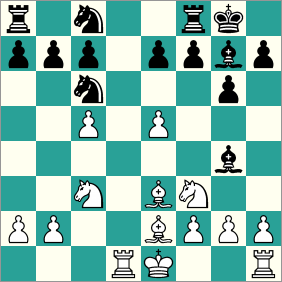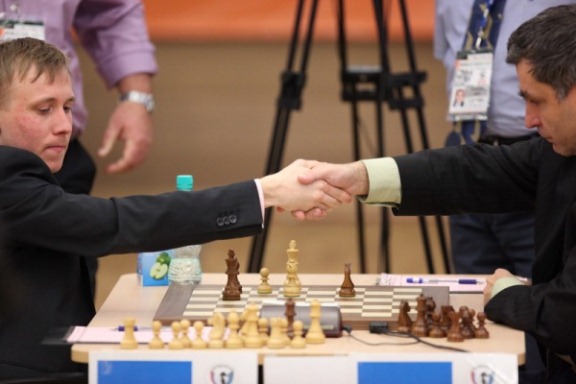 The third games of the final matches at the World Cup could have been the last if Peter Svidler and Vassily Ivanchuk had won, but instead there were two hard-fought draws. That means we’re all set for one last battle in classical chess – Alexander Grischuk and Ruslan Ponomariov have to win to force tiebreaks.
The third games of the final matches at the World Cup could have been the last if Peter Svidler and Vassily Ivanchuk had won, but instead there were two hard-fought draws. That means we’re all set for one last battle in classical chess – Alexander Grischuk and Ruslan Ponomariov have to win to force tiebreaks.
First published but no longer available at WhyChess – more here
On Day 3 Svidler surprised Grischuk by playing 3…Bc5 in the Ruy Lopez. After 8.exd6 the following position was reached:
Russian commentator Sergey Shipov explained that the normal move is 8…0-0, which seems fine for Black. He also noted that a Brazilian had taken the pawn with 8…Nxd6, but dismissed that as the chess-playing exploits of someone who was clearly more of a footballer. However, not for the first time in the final, Svidler took the unexpected option, which caused Grischuk to use up a lot of time. He revealed after the game that he’d been considering a long line: 9.Bxc6+ bxc6 10.cxd4 Bb6 11.Re1+ Be6 12.Bg5 Qb8 13.Ne5 Qb7 14.Qf3 Bxd4 15.Nxf7, until he realised Black can reply O-O!

Shipov was in remarkably good spirits considering he now has to explain to Peter Svidler why he compared his chess to that of a Brazilian footballer…
Forced to find an alternative Grischuk chose 9.Re1+ (a novelty, as the Brazilian game did indeed go 9.Bxc6+). White had a better structure and, it seemed, real winning chances, but that was forgetting two things: Svidler’s recent run of four classical wins with the black pieces and, more importantly, Grischuk’s time-trouble brinkmanship.
Svidler has proved adept at playing quickly and accurately when his opponent is short of time. It worked again, as Grischuk ended up playing on 30 second increments and Svidler smoothly seized the initiative – and an extra pawn. However, 28…h5 brought an abrupt end to proceedings (28…Bxb3 or 28…Rd2 would have prevented what followed, though it’s unlikely they would have altered the final outcome):
Grischuk played 29.Rxf7 and 29…Kxf7 came with a draw offer that was accepted (30.Nd6+ would follow).
There were no such swings in the game between Vassily Ivanchuk and Ruslan Ponomariov. Afterwards Ivanchuk admitted that he’d mixed something up in the opening and ended up a pawn down for almost no compensation. A key moment in their Grunfeld Defence came after 13…Nc8:
Here Ivanchuk defended the pawn with the clumsy looking 14.Bf4. Ponomariov said he was much more worried about the 14.h3 pawn sac that Karpov had used to beat Kasparov in their 1986 match. He felt White wouldn’t be risking anything there, while in the following position after 19…Rb8 Ivanchuk adopted a radical approach:
He played 20.Ne4!?, after which Ponomariov simply took the pawn on b2. In the play that followed – and the game lasted 82 moves – it’s not immediately clear how great Black’s winning chances were, or where he let something slip. Ponomariov himself thought he exchanged too much material and noted some moments at which he might have missed something. However, a quick computer analysis doesn’t suggest better alternatives. Ivanchuk ended the game with the kind of little trick that often works with such limited material:
79.g6! f5 80.Nd6! Bd4 (if you take the knight the pawn queens) 81.Nxf5+ exf5 82.Bxf5 Bg7 – and even such uncompromising fighters were forced to call it a day.
So the 2011 World Cup is almost over. On Monday 19 September Grischuk must beat Svidler with the black pieces, while Ponomariov must overcome Ivanchuk with White. Otherwise Svidler will win the World Cup, and Ivanchuk will finally have qualified for another Candidates Tournament. Don’t miss it!









